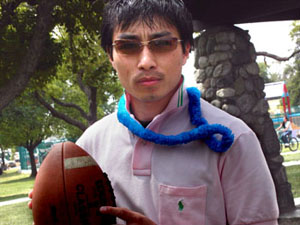People
 Xin
Heng Xin
Heng
Education
Ph.D, Electrical Engineering, Caltech 2007
M.S., Applied Physics, Caltech 2003, USA
B.S.,
Physics, with honors, Nanjing University, China, 2002
Research Projects
1) Optofluidic microscopy - A method for implementing a high
resolution optical microscope on a chip
This project aims at creating an optical microscope on a microfluidic
chip that contains no bulk optical elements. It is termed the Optofluidic
microscope, or OFM.
There are inherent advantages of using optics in microfluidic
applications. For example, light interrupts fluids negligibly
and it is non-destructive to biological samples. We attempt to
revolutionize the concept of microfluidic circuitry by miniaturizing
this optical imaging unit while using microfluidics for
sample delivery. In recent experiments, high resolution, high
throughput imaging has been successfully demonstrated by using
one of the most popular animal models, Caenorhabditis elegans
(C. elegans). Out first prototype device has also been used to perform
nematode phenotyping, in which field subtle morphological variations
between different genotypes were usually qualitatively described.
The advantages of OFM make it perfectly suited as a highly-automated
system that requires nearly no labor-intensive observation or
sample counting. More modalities such as Raman imaging, fluorescence
and spectroscopy can be readily integrated into this system.
We strongly believe OFM is a significant advancement in the development
of the next-generation optics-lab-on-a-chip that will improve
the quality of life by modernizing biomedical research and clinical
testing.
2) A high resolution optofluidic microscope with a stable optical
trap
In previous work, we combined OFM with microfluidics and demonstrated
the first OFM prototype with C. elegans imaging. Relatively large
apertures (600 nm in diameter) were used, and the resulting resolution
was only comparable with a conventional microscope. In this work,
we use subwavelength nanoapertures (<200nm in diameter) to
demonstrate high resolution OFM. Furthermore, we choose optical
tweezers as our new sample manipulation scheme. In this design,
optical tweezers immobilize cells and then move them across the
nanoaperture array with a constant speed. The stable optical
trap is formed above an aluminum surface and the cells are able
to remain in close proximity with the nanoaperture plane throughout
scanning. We prove that optical trapping is a promising technique
to combine with OFM. High imaging throughput of OFM can be accomplished
by employing an optical trap array.
3) Homodyne based optical coherence microscopy
This project is to bridge confocal laser scanning microscope
(CLSM) and optical coherence tomography (OCT) and thus create
a new imaging modality in the field of tomography imaging.
It is named Optical Coherence Microscope (OCM). OCM distinguishes
itself from conventional OCT configurations because of its
capability of delivering micron-level volumetric (3D) resolution
in biomedical imaging by combining the 'gating' ability
of low-coherence interferometer and the high-N.A. of CLSM imaging
technique.
For more details, please refer to the website of my colleague,
Zahid Yaqoob.
4) Microfluidic display
The project specifically aims at making use of the state of the
art microfluidic technology to build a fluorescence display.
It is a new concept that differs from any other existing scheme
such as CRT, LCD and plasma display. It will be competitive
in the display market because of its low cost, fast modulation
and compact size.
For more details, please refer to the website of my colleague,
Xiquan Cui.
Publications
Xin Heng, David Erickson, L. Ryan Baugh, Zahid Yaqoob, Paul
W. Sternberg, Demetri Psaltis and Changhuei Yang, Optofluidic
microscopy- a method for implementing a high resolution optical
microscope on a chip, Lab on a Chip 6 (10): 1274 - 1276,
2006.
Xin Heng, Xiquan Cui, David Knapp, Jigang Wu, Zahid Yaqoob,
E. J. McDowell, Demetri Psaltis and Changhuei Yang, Determining
the resolution limit of nano aperture based optical imaging or
sensing device, Optics Express 14 (22): 10410 - 10425,
2006.
For other co-written articles of mine, please check the websites
of my colleagues or the 'Publications' section. |